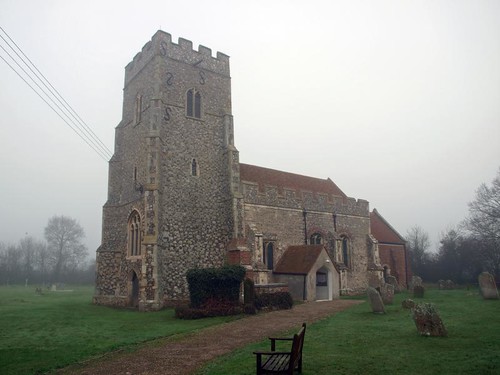UPDATE 20/08/15: Had to make a delivery just up the road today and stopped off on my way home and the keyholder was in. Very disappointing inside as it has been thoroughly airbrushed and there is little of interest. I saw no sign of the brass and thought Pevsner very harsh on the font - I thought it rather good of its kind.
ST ANDREW. Nave, chancel, and W tower - all Perp. The W tower is of flint and stone and has diagonal buttresses. The battlements have a trellis pattern of ashlar against the flint ground. Above the W door is an inscription which reads as follows: ‘Orate pro animabus dominorum Iohannis Wylson et Iohannis Hyll quorum animabus propicietur dens amen.’ They no doubt paid for the building of the tower. The nave is of flint, embattled, the chancel lower and of brick. - FONT. Octagonal, Perp, with fleurons on the foot, panel tracery on the stern, and on the bowl figures of angels, saints, a baptism, the martyrdom of St Andrew, etc. The figure carving is thoroughly bad. - BRASS to William Hyklott d. 1508 ‘which paide for the werkemanship of the wall of this churche’.
ALTHORNE. Charming here it is to see the white-sailed boats coming up the wide estuary with the flowing tide, and delightful to come to the church by the grassy lane. In the church is a gem which should draw every traveller this way - a font exquisitely carved about the year 1400, recording for all time the costume worn by kings and queens and ordinary people of that age. The panels of the bowl are cut deep to throw the figures in strong relief. Here is a seraph feathered from crown to foot, and stately withal; here is a royal prince at a font with a priest baptising him; in another panel stands a king with his queen beside him, plucking at her gown as if to curtsy.
The church is 14th century, the tower 15th, its embattled parapet enriched with flints in a trellis work of stone giving it great beauty. On a nave buttress is a medieval scratch dial. An inscription below a portrait brass tells us that this is William Hyklott, who paid for the wall of the church; he is with two daughters, one dressed as a nun, and engraved with them are a delightful Madonna and Child.
Flickr.
The church is 14th century, the tower 15th, its embattled parapet enriched with flints in a trellis work of stone giving it great beauty. On a nave buttress is a medieval scratch dial. An inscription below a portrait brass tells us that this is William Hyklott, who paid for the wall of the church; he is with two daughters, one dressed as a nun, and engraved with them are a delightful Madonna and Child.
Flickr.

No comments:
Post a Comment